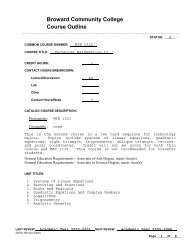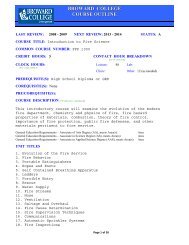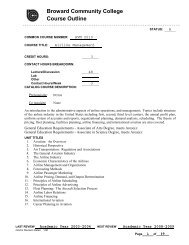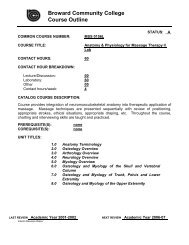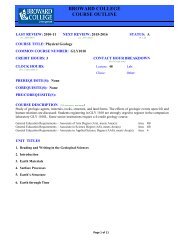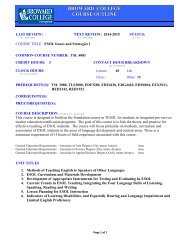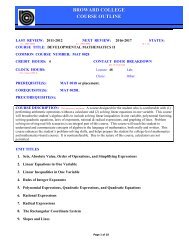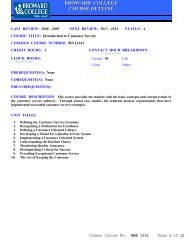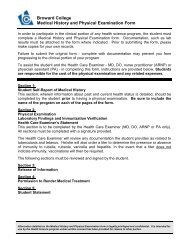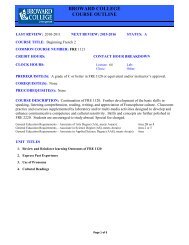PHY2049.pdf - Broward College
PHY2049.pdf - Broward College
PHY2049.pdf - Broward College
Create successful ePaper yourself
Turn your PDF publications into a flip-book with our unique Google optimized e-Paper software.
BROWARD COLLEGE<br />
COURSE OUTLINE<br />
LAST REVIEW: 2010-11 NEXT REVIEW: 2015-16 STATUS: A<br />
(i.e. 2003-2004) (i.e. 2008-2009) (A, I, D)<br />
COURSE TITLE: General Physics with Calculus II<br />
COMMON COURSE NUMBER: PHY 2049<br />
CREDIT HOURS: 4<br />
CONTACT HOUR BREAKDOWN<br />
(per 16 week term)<br />
CLOCK HOURS: Lecture: 64 Lab:<br />
(Voc. Course ONLY)<br />
Clinic:<br />
Other:<br />
PREREQUISITE(S): PHY 2048 and MAC 2312 with a minimum grade of C<br />
COREQUISITE(S): PHY 2049L and MAC 2313 with a minimum grade of C<br />
PRE/COREQUISITE(S):<br />
COURSE DESCRIPTION (750 characters, maximum):<br />
PHY 2049 is part two of a comprehensive physics course outlining electricity, magnetism and<br />
optics using analysis in calculus.<br />
General Education Requirements – Associate of Arts Degree (AA), meets Area(s): 4B<br />
General Education Requirements – Associate in Science Degree (AS), meets Area(s): 4B<br />
General Education Requirements – Associate in Applied Science Degree (AAS), meets Area(s):<br />
Area<br />
Area<br />
Area<br />
UNIT TITLES<br />
1. Electricity and Magnetism<br />
2. Optics<br />
3. Quantum Theory<br />
Page 1 of 7
BROWARD COLLEGE<br />
COURSE OUTLINE<br />
*** Complete the following only if course is seeking general education status ***<br />
GENERAL EDUCATION Competencies and Skills *:<br />
In the box to the right of the Competency/Skill, enter all specific student learning outcome unit numbers, as indicated in the course outline<br />
(i.e. 1.1, 2.7, 4.2, 4.0 and 5.12) that apply.<br />
Course must include all of the following:<br />
1. Read with critical comprehension** 1.0, 2.0, 3.0<br />
2. Write clearly and coherently** 1.0, 2.0, 3.0<br />
3. Demonstrate literacy as appropriate within a given E: 1.0, 2.0, 3.0<br />
discipline**<br />
F: 1.0, 2.0, 3.0<br />
4. Apply problem solving skills or methods to make 1.0, 2.0, 3.0<br />
informed decisions in a variety of contexts**<br />
Course must include at least one of the following:<br />
5. Differentiate between ethical and unethical behavior<br />
6. Demonstrate an understanding of the physical,<br />
biological, and social environments and how individual<br />
behaviors impact this complex system.<br />
7. Demonstrate an understanding of and appreciation for<br />
human diversities and commonalities.<br />
8. Speak and listen effectively.<br />
1.0, 2.0, 3.0<br />
*General Education Competencies and Skills endorsed by 2010-2011 General Education Task Force<br />
**Required Competencies<br />
1) Read with critical comprehension.<br />
The student will be introduced to the basic texts, concepts, vocabulary, and methods necessary for developing<br />
an understanding of the discipline and meeting the required benchmarks as stated in the course outline.<br />
2) Write clearly and coherently.<br />
The student will demonstrate an understanding and mastery of subject matter in a variety of ways, including<br />
writing. Writing activities may include both graded and ungraded essays, short answer quizzes, summaries,<br />
reactions, journals, and various other reports.<br />
3) Demonstrate and apply literacy across all the disciplines (indicate which ones apply).<br />
a) Information literacy means understanding how to locate needed information, using the appropriate<br />
technology for the task, managing and evaluating the extracted information and using it effectively and<br />
ethically.<br />
b) Technology literacy is the ability to responsibly and effectively use appropriate technology to access,<br />
manage, integrate, or create information, and/or use technology to accomplish a given task.<br />
c) Workplace literacy is having the appropriate knowledge and skills to communicate and work with<br />
others effectively and perform job duties, whether it is through the use of computers and/or other<br />
technology.<br />
d) Cultural literacy is recognizing, understanding, and appreciating the similarities and differences<br />
between one’s own culture and the cultures of others through a study of the arts, customs, beliefs,<br />
values, and history that define a culture.<br />
e) Quantitative literacy is having the ability to formulate, solve and interpret mathematical/statistical<br />
operations and graphical/tabular representations to make informed decisions.<br />
f) Scientific literacy means understanding the methodology and application of the scientific process, the<br />
physical and biological worlds, and recognizing that scientific knowledge is continuously updated or<br />
revised as new information is discovered.<br />
Page 2 of 7
BROWARD COLLEGE<br />
COURSE OUTLINE<br />
g) Environmental literacy is creating a context within which environmental issues can be viewed, imparting<br />
knowledge to enhance one’s ability to analyze the issues, make the connections between humans’ decisions and<br />
actions and the challenges facing the environment, and instilling the desire to sustain the environment through<br />
ethical practices in both one’s professional and personal lives.<br />
4. Apply problem-solving skills or methods to make informed decisions in a variety of contexts.<br />
The student will use acquired skills or methods to recognize, analyze, adapt, and apply critical<br />
thinking to solve problems and make informed decisions.<br />
Page 3 of 7
BROWARD COLLEGE<br />
COURSE OUTLINE<br />
EVALUATION:<br />
In the box to the right of the Methods of Assessment, enter all specific learning outcome numbers (i.e. 1.1, 2.7, 4.0, 4.2 and 5.12) that apply.<br />
1. Portfolio 1.0, 2.0, 3.0<br />
2. Short essays<br />
3. Research Papers 1.0, 2.0, 3.0<br />
4. Group projects<br />
5. Discussions (In class and online)<br />
6. Multiple Choice tests 1.0, 2.0, 3.0<br />
7. Presentations<br />
8. Service Learning Projects<br />
9. Quizzes (pop, announced, etc.) 1.0, 2.0, 3.0<br />
10. Take-home tests 1.0, 2.0, 3.0<br />
11. Summaries, critiques, and analyses<br />
12. Reaction papers<br />
13. Surveys<br />
14. Performance<br />
15. Short answer tests 1.0, 2.0, 3.0<br />
16. Classroom debates and colloquia<br />
17. Blogs, wikis, web pages<br />
18. Other (Please explain)<br />
Page 4 of 7
BROWARD COLLEGE<br />
COURSE OUTLINE<br />
Common Course Number: PHY 2049<br />
UNITS<br />
Unit 1<br />
Electricity and Magnetism<br />
General Outcome:<br />
1.0 The student shall: be able to analyze how electrical and magnetic fields<br />
combine to create the electromagnetic force in electrical circuits. The<br />
student will read the course materials critically and create written<br />
solutions that will allow for analysis of these circuits.<br />
Specific Measurable Learning Outcomes:<br />
Upon successful completion of this unit, the student shall be able to:<br />
1.1. Analyze Coulomb’s law in two- and three-dimensional charge configurations.<br />
1.2. Analyze the concept of electric field to discrete and continuous bodies using Gauss’s<br />
Law.<br />
1.3. Analyze Ohm's Law and Kirchhoff's Laws to solve simple and compound circuits to<br />
create voltage and power relationships in RCL AC circuits.<br />
1.4. Analyze magnetic fields effects on moving charged particles and current-bearing wires<br />
using Ampere’s Laws and Biot-Savart’s Laws.<br />
1.5. Analyze electromagnetic fields using Faraday's and Lenz's Laws to determine the<br />
magnitude and direction of the electromagnetic force.<br />
Page 5 of 7
BROWARD COLLEGE<br />
COURSE OUTLINE<br />
Common Course Number: PHY 2049<br />
Unit 2 Optics<br />
General Outcome:<br />
2.0 The student shall: be able to analyze problems involving geometrical<br />
and physical optics. The student will read the course materials<br />
critically and create written solutions that will allow for analysis of<br />
optical systems.<br />
Specific Measurable Learning Outcomes:<br />
Upon successful completion of this unit, the student shall be able to:<br />
2.1. Analyze the law of reflection and Snell’s Law of Refraction to various optical boundaries.<br />
2.2. Construct ray diagrams for mirrors and lenses.<br />
2.3. Analyze thin-film and double-slit interference, single-slit diffraction patterns, emission and<br />
absorption spectra and polarization affects using electric and magnetic field vectors.<br />
Page 6 of 7
BROWARD COLLEGE<br />
COURSE OUTLINE<br />
Common Course Number: PHY 2049<br />
Unit 3 Quantum Thoery<br />
General Outcome:<br />
3.0 The student shall: be to analyze concepts of quantum theory and<br />
probability waves. The student will read the course materials critically<br />
and create written solutions that will allow for analysis of quantum<br />
theory.<br />
Specific Measurable Learning Outcomes:<br />
Upon successful completion of this unit, the student shall be able to:<br />
3.1. Analyze the following concepts:<br />
3.1.1. The deBroglie wavelength.<br />
3.1.2. The photoelectric effect.<br />
3.1.3. Radioactive decay.<br />
3.2. Analyze particle behavior using a one-dimensional particle in the box.<br />
Page 7 of 7



